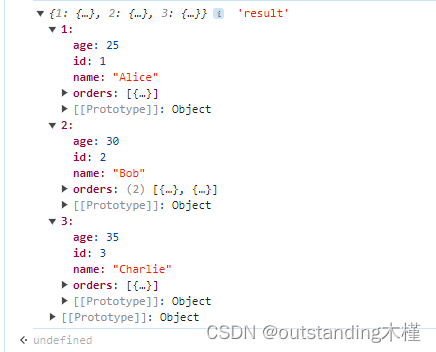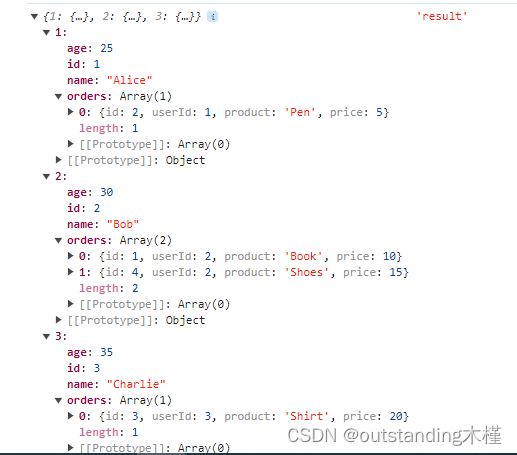目录
参数
| ||||||||||
| initialValue | 可选。作为初始值传递给函数的值。 |
array.reduce(function(total, currentValue, currentIndex, arr), initialValue)注释:对没有值的数组元素,不执行 reduce() 方法。
注释:reduce() 方法不会改变原始数组。
1. 数组求和、求乘积、求平均数、求最大,最小值
// 求和 const num = [1, 2, 3, 4, 5] const result1 = num.reduce((sum, n) => sum + n, 0) console.log(result1); // 15 // 求乘积 // const result2 = num.reduce((sum, n) => sum * n) const result2 = num.reduce((sum, n) => sum * n, 1) console.log(result2); // 120 // 求平均数 const num = [1, 2, 3, 4, 5] const result3 = num.reduce((sum, n) => sum + n, 0)/num.length console.log(result3); // 3 // 求最大,最小值 const num = [1, 2, 3, 4, 5]; const max = num.reduce((acc, cur) => Math.max(acc, cur)); console.log(max); // 5 const min = num.reduce((acc, cur) => Math.min(acc, cur)); console.log(min); // 1
2. 累加数组中对象的值
let numObj = [{n: 1}, {n: 2}, {n: 3}, {n: 4}, {n: 5}] let result3 = numObj.reduce((sum, obj) => sum + obj.n, 0) console.log(result3); // 15
3. 计算数组中每个元素出现的次数
let colors = ['red', 'orange', 'yellow', 'green', 'blue', 'indigo', 'purple', 'red'] let countColor = colors.reduce(function(all, color){ if(color in all) { all[color]++; } else { all[color] = 1; } return all; }, {}); console.log(countColor); // {blue: 1, green: 1, indigo: 1, orange: 1, purple: 1, red: 2, yellow: 1} let arr = ['a', 'b', 'c', 'a', 'b']; let count = arr.reduce((obj, item) => { // 如果对象中已经有了这个键,就让它的值加一 if (obj[item]) { obj[item]++; } else { // 如果对象中没有这个键,就初始化为一 obj[item] = 1; } // 返回对象作为下一次的累计值 return obj; }, {}); // 初始值为空对象 console.log(count); // {a: 2, b: 2, c: 1}
4. 数组去重
let arr = [1, 2, 3, 4, 4, 1] let newArr = arr.reduce((pre,cur)=>{ if(!pre.includes(cur)){ return pre.concat(cur) }else{ return pre } },[]) console.log(newArr); // [1, 2, 3, 4]
5. 二维数组变一维数组
let twoArray = [[0, 1], [2, 3], [4, 5]] let oneArray = twoArray.reduce((arr, val) => arr.concat(val), []) console.log(oneArray); // [0, 1, 2, 3, 4, 5]
6. 将多维数组转化为一维
let moreArr = [[0, 1], [2, 3], [4,[5,6,7]]] const resultArr = function(moreArr){ return moreArr.reduce((pre,cur) => pre.concat(Array.isArray(cur) ? resultArr(cur) : cur), []) } console.log(resultArr(moreArr)); // [0, 1, 2, 3, 4, 5, 6, 7]
7. 根据属性把对象分类
let peopleInfo = [ {name: 'aaa', age: 15, sex: '男'}, {name: 'bbb', age: 16, sex: '女'}, {name: 'ccc', age: 15, sex: '女'} ] function groupBy(objectArray, property) { return objectArray.reduce((resultObj, obj) => { var key = obj[property] if(!resultObj[key]) { resultObj[key] = [] } resultObj[key].push(obj) return resultObj; }, {}) } let peopleAgeGroup = groupBy(peopleInfo, 'age') console.log(peopleAgeGroup); // {15: [{name: "aaa", age: 15, sex: "男"}, {name: "ccc", age: 15, sex: "女"}],16: [{name: "bbb", age: 16, sex: "女"}]} let peopleSexGroup = groupBy(peopleInfo, 'sex') console.log(peopleSexGroup); // {男: [{name: "aaa", age: 15, sex: "男"}], 女: [{name: "bbb", age: 16, sex: "女"}, {name: "ccc", age: 15, sex: "女"}]}
8. 将数组转换为对象
const entries = [['name', 'Alice'], ['age', 18], ['gender', 'female']]; const obj = entries.reduce((acc, cur) => { acc[cur[0]] = cur[1]; return acc; }, {}); console.log(obj); // {name: "Alice", age: 18, gender: "female"}
9. 将对象转换为数组
const obj = { name: 'Alice', age: 25, gender: 'female' }; const arr = Object.keys(obj).reduce((acc, key) => { acc.push([key, obj[key]]); return acc; }, []); console.log(arr); // [['name', 'Alice'], ['age', 25], ['gender', 'female']]
10. 按条件分组
假设我们有一个包含学生信息的数组,每个对象都有name和score属性,我们想要按照score是否大于等于60来分组,即及格和不及格。我们可以使用reduce这样做:
// 定义一个学生数组 const students = [ {name: 'Alice', score: 75}, {name: 'Bob', score: 59}, {name: 'Charlie', score: 82}, {name: 'David', score: 48}, {name: 'Eve', score: 66} ]; // 使用reduce按条件分组 const groups = students.reduce((acc, cur) => { // 判断当前对象的score是否大于等于60 const key = cur.score >= 60 ? 'pass' : 'fail'; // 如果累积对象中还没有这个key,就创建一个空数组 if (!acc[key]) { acc[key] = []; } // 将当前对象推入对应的数组 acc[key].push(cur); // 返回累积对象 return acc; }, {}); // 初始值为一个空对象 // 打印结果 console.log(groups); /* { pass: [ { name: 'Alice', score: 75 }, { name: 'Charlie', score: 82 }, { name: 'Eve', score: 66 } ], fail: [ { name: 'Bob', score: 59 }, { name: 'David', score: 48 } ] } */
11. 将多数组合并为一个对象
将多个数组合并为一个对象(下面示例最终展示结果有层级)
要实现这个功能,我们可以使用reduce方法的第二个参数,即初始值。初始值可以是任何类型的值,包括一个空对象。然后,在reduce方法的回调函数中,我们可以根据数组元素的某个属性(例如用户ID)来判断是否已经存在对应的对象属性。如果不存在,就创建一个新的属性,并将数组元素赋值给它。如果存在,就将数组元素追加到已有的属性中。最后,返回累积的对象作为下一次迭代的初始值。
// 用户信息数组 const users = [ { id: 1, name: "Alice", age: 25 }, { id: 2, name: "Bob", age: 30 }, { id: 3, name: "Charlie", age: 35 }, ]; // 用户订单数组 const orders = [ { id: 1, userId: 2, product: "Book", price: 10 }, { id: 2, userId: 1, product: "Pen", price: 5 }, { id: 3, userId: 3, product: "Shirt", price: 20 }, { id: 4, userId: 2, product: "Shoes", price: 15 }, ]; // 使用reduce方法将两个数组合并为一个对象 const result = users.reduce((acc, cur) => { if (!acc[cur.id]) { // acc初始是空{},要把users数组中的值存到acc中,比如第一次cur为users的第一条数据,cur.id=1,acc[1]=underfined,因为再空{}里找不到索引1的,!underfined = true 判断是否已经存在对应用户ID的属性 acc[cur.id] = cur; // 如果不存在,创建一个新的属性,并将用户信息赋值给它 console.log(acc, 'acc1') // 1: {id: 1, name: "Alice", age: 25} acc[cur.id].orders = []; // 同时,创建一个空数组用来存储用户订单 console.log(acc, 'acc2') // 1: {id: 1, name: "Alice", age: 25, orders:Array(0)} } for (let item of orders) { // 遍历订单数组,找到属于当前用户的订单 if (item.userId === cur.id) { acc[cur.id].orders.push(item); // 将订单追加到用户订单数组中 } } return acc; // 返回累积的对象 }, {}); // 初始值为空对象 // 打印结果 console.log(result);
12. 将字符串转化为对象
经常会遇到在url上进行取值,当然这有很多种方法,我们用reduce方法来实现。
// 将URL参数转化为对象 let url = "https://www.example.com?name=Tom&age=20&gender=male"; let params = url.split("?")[1]; // 获取参数部分 let obj = params.split("&").reduce((acc, cur) => { let [key, value] = cur.split("="); // 分割键和值 acc[key] = value; // 将键和值添加到对象中 return acc; }, {}); // 初始值为空对象 console.log(obj); // {name: "Tom", age: "20", gender: "male"}
13. 检查字符串是不是回文字符
如果我们想要检查一个字符串是否是回文字符串,即正着读和反着读都一样
首先,我们将字符串转换为数组,然后使用reduce方法从右到左遍历数组,将每个元素拼接到累积器上,得到一个反转后的字符串。然后,我们将反转后的字符串和原始字符串进行比较,如果相等,则说明是回文字符串,否则不是。
例如,给定字符串"racecar",我们可以这样写:
const isPalindrome = str => { // 将字符串转换为数组 const arr = str.split(''); // 使用reduce方法从右到左遍历数组,将每个元素拼接到累积器上 const reversedStr = arr.reduce((accumulator, currentValue) => currentValue + accumulator, ''); // 将反转后的字符串和原始字符串进行比较 return reversedStr === str; }; console.log(isPalindrome('racecar')); // true console.log(isPalindrome('hello')); // false // 或者这样写: const fun = str => { let result = str.split('').reverse().toString().replaceAll(',','') return result === str } console.log(fun('abcd')) // false console.log(fun('abba')) // true
这个博主:

























 1904
1904











 被折叠的 条评论
为什么被折叠?
被折叠的 条评论
为什么被折叠?








